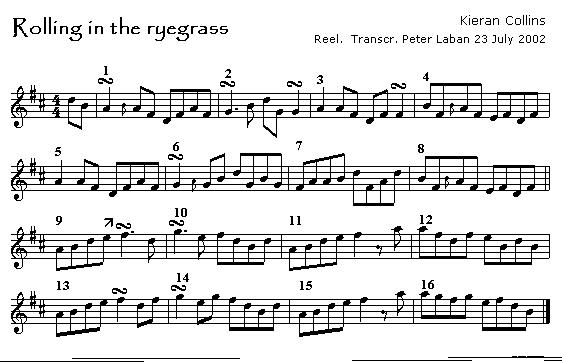A brief analysis by Peter Laban, 23 July 2002
From a recording by Kieran Collins from the 1970s. (Collins was a whistle player from the Gort/Peterswell area of East Galway, I don't have more exact biographic notes handy). A selection of tunes was played on a Bflat whistle: Rolling in the ryegrass and The Boyne hunt, both played through three times. He starts the first tune slowly, finding his rhythm, once settled into the tune, the playing accelerates going into the second part and continues from there on at a comfortable steady speed.
Collins uses a fair amount of variation in the use of his ornamentation, exchanging short, long and off-beat rolls and tongued fairly non-legato runs to emphasise the tune's rhythm. He introduces some interesting twists to break monotony in this simple structured reel. Some more variation is introduced in the second and third playing of the tune; for now however only the first playing is presented here.

Bar 1 the tune opens with a strong rhythmic statement of a short roll on A followed by another a emphasised by a strong cut, this immediately holds the attention as the listener familiar with the tune may have expected a long roll of a dotted quaver followed by f .
Bar 2. In contrast the second phrase which could be expected to go as follows ~G BG dGBG in a standard version opens with a very pleasing long roll on G with B leading into dG off-beat G roll. A fairly common variation of this movement but introduction of it in the first playing sets the mood and creates expectations for what is to come.
Bar 3 would normally be the same as the opening bar; to break monotony however ornamentation on A is left out, the notes being tongued separately instead DFAF becomes DF ~F the off-beat roll giving a lighter emphasis leading up to the end of the phrase on low D in Bar 4.
Bar 5 is again the same melodic figure as bars 1 and 3, this time the notes are tongued as in bar 3 but the bar is resolved as it was the first time around.
Bar 6 shows another variant of the ~G BG dGBG figure which emphasises the Gs. Rhythmic structure here echoes the opening bar of the tune.
Bar 7 again shifts the stress to the off beat by opening on F and shiftting the expected accent As a bit down the line, raising the expected D an octave and finishing the bar on another high d is another subtle touch leading into the resolution of the phrase which is the same as the first time round in bar 4.
The opening of the turn of the tune is coloured by a slide into a long roll on f in Bar 9 followed by a long roll on another long roll on g in Bar 10 both long rolls create a bit of "space" in the tune
Bar 11 announces the return of the more choppy rhythms with a strong short f (to create a bit of breathing space for the player) but instead of ending the phrase on a long e in bar 12 the flow of the tune is kept going by dropping down to b: eBdB, another nice little touch.
The more choppy rhythms do arrive however when the long rolls in the opening phrases of the turn become strongly accented short rolls: ~f df in bar 13 and ~g eg in bar 14 respectively. The tune nears its conclusion here and while bar 15 is identical to bar 11, bar 16 brings another nice twist when instead of afdf the player changes the tonal colour completely when he goes agfg instead, before ending the tune on e and leading back to to the start through fdB (which is another variation on the previous).
Please note the transcription was done with an imperfect ear and without slowing down devices, while I have indicated certain notes used in cuts, I am not always sure if a cut on an A is done with B or C. Also, when listening to the piece the first time my impression was that more rolls were used eg it seemed he rolled the second A in bar 1 as well, closer listening made me decide he actually didn't. As always there are some ambiguities the ear cannot quite resolve.
Peter Laban